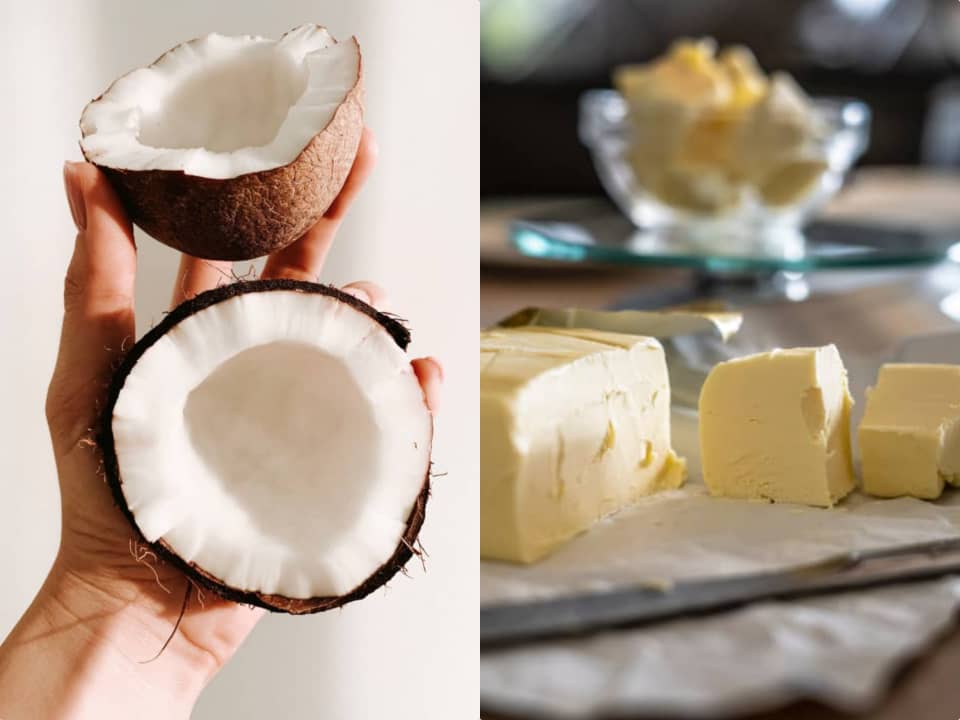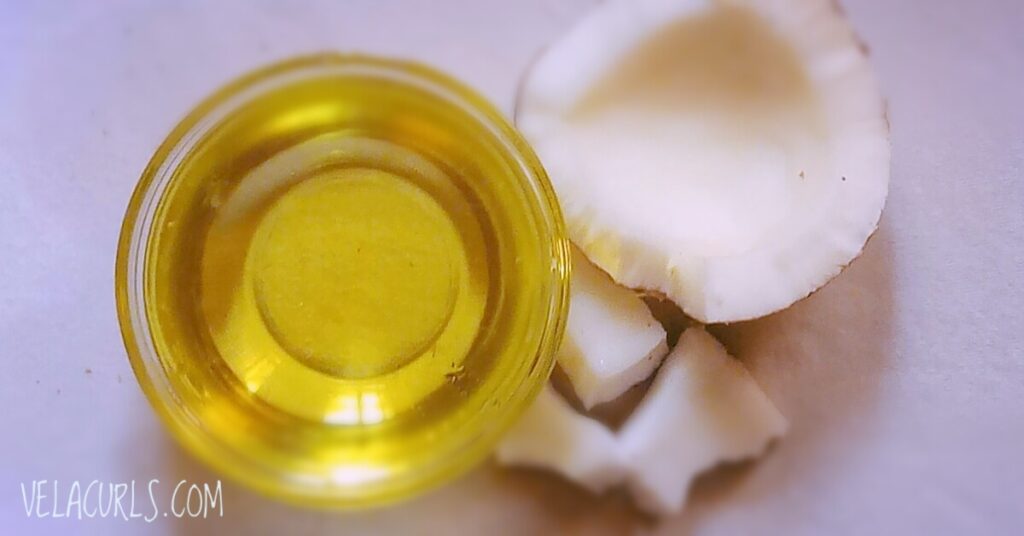Many are familiar with the use of coconut oil and Shea butter for hair.
Shea butter is well known for its excellent moisturizing effects and coconut oil for its fantastic conditioning effects.
Well, imagine you had to let one go for the other. Which would you choose?
Which is better for hair: Coconut oil or Shea butter?
Okay, stop imagining now.
Ideally, you shouldn’t use both at a time as regular ingredients on your hair.
They are both sealants, and overuse of moisture sealants can lead to clogged hair pores.
This article will help you figure out what’s best for hair: coconut oil or shea butter?
So, do your hair pores some good – sit back, relax and read on!

Shea Butter vs. Coconut Oil: Which is better for Hair?
It is worthy to note that both shea butter and coconut oil are hair butter (especially when coconut oil is in its solid form)
Hair butter is a concentrated natural oil.
At a relatively high temperature, it would melt and become liquid.
Both coconut oil and shea butter contain almost the same amount of saturated and monounsaturated fatty acids.
This presence of fatty acids, easy availability in most areas, and relatively low price make coconut oil and shea butter excellent hair ingredients.
Coconut oil contains 80% of saturated fatty acids, including 50% of lauric acid.
It is the richest natural source of medium-chain fatty acids (MCAFs).
Hence, it penetrates the hair shaft more than any other hair oil. However, it is not for all hair types.
There have been mixed comments from people who used coconut oil. Some are good, some are bad.
So how do you know if coconut oil is better for your hair?
This knowledge will help:
Coconut oil is excellent for fine to medium shiny hair.
It is recommended for low porosity hair. As a sealant, it helps it to retain moisture.
Because of its lauric acid content, it can cause more brittleness, frizzing, and loss of coarse hair.
Like coconut oil, shea butter contains an almost equal amount of monounsaturated and saturated acids.
It is also rich in vitamins such as vitamin A, E, and K.
That makes it an excellent sealant; exactly what low porosity hair needs!
There is a broader scope for shea butter, though; it is also great for medium porosity hair.
High porosity hair, on the other hand, will only get frizzier with shea butter.
Shea butter is also great for hair ends and as an additive to hair conditioners.
So let’s summarize this explanation so you can get the point;
Which Hair Type is better for Shea Butter?
- Low porosity hair
- Medium porosity hair
- Curly and coarse hair textures

Which Hair Type is better for Coconut Oil?
- Low porosity hair
- Fine to medium shiny hair
Hair Porosity for Shea Butter vs. Coconut Oil
Since your hair porosity majorly determines which is best for you coconut oil or Shea butter, this post would not be complete without discussing what hair porosity is and how you can verify your hair porosity.
So let’s get to it.
What is Hair Porosity?
Simply put, it is a measure of your hair’s ability to take in and retain moisture.
So when you provide moisture to your hair, how well does it receive it, and how long does it take before you have to provide moisture to it again for good health?
That measure is your hair’s porosity.
Now, there are ways to know your hair’s porosity, and yes, we’ll get there.
First, let’s see the three categories of hair porosity; your hair falls between one of the three.
Types of Hair Porosity
Low hair porosity
This refers to hair with closely placed cuticles.
Your hair cuticle is the outermost, protective layer of your hair shaft.
It’s made up of millions of tiny little scales that are in layers, such that they limit friction between hair strands.
Okay, I’ll save you the stress of feeling like you are in a science class right now.
Keep in mind that your hair cuticle is the outermost part of your hair shaft and that when they are closely placed together, your hair has low porosity.
This means that it is hard for moisture and oil to get through to your hair shaft; where it is needed.
Most natural hairs have low porosity since the hair cuticle has not been ‘opened’ by relaxers or hair dyes.
Low porosity hair tends to take a longer time to dry naturally.
It also doesn’t get saturated by water quickly. People with low porosity hair have to pour water multiple times to get their hair wet for shampooing.
If that describes your hair, whoops, you found your spot!
Medium/normal hair porosity
Medium porosity hair is somewhere in the middle.
Hair cuticles are not too closely placed but neither are they placed too far from each other.
It absorbs moisture easily and retains it for a long time.
You could call it the perfect hair porosity.
People with medium hair porosity can keep hairstyles for a long time, and it would not quickly look rough. Such hair is also easy to style.
It’s easy to color, looks healthy, and doesn’t take too long to dry.
If this describes your hair, you probably have normal hair porosity.
If it doesn’t, well, look closely at the other two.
High hair porosity
As you may have guessed, this refers to hair with loosely placed cuticles.
The hair cuticles are far from each other.
Because of this, high porosity hair absorbs moisture easily but also loses it quickly. It does not retain moisture for long.
Most hairs in this category are there due to genetics or hair damage.
It is characterized by easy hair breakage, frizz, dryness, and is easy to air dry.
How to Know Your Hair Porosity
Apart from the characteristics described above, you can confirm your hair porosity by carrying out the simple test described below.
Don’t forget; it’s shea butter for medium and low hair porosity and coconut oil for low hair porosity only.
So once you’ve determined your hair porosity, don’t just run off with the knowledge.
Use it to decide which is better for your hair coconut oil or shea butter.
Hair Porosity Test
- Wash and apply a conditioner to your hair.
- Allow it to dry naturally. This will prevent the influence that heat styling may have on the result.
- Get water in a bowl. The water should be at room temperature.
- Remove a strand of your hair and drop it inside the bowl of water.
- Observe the hair strand.
Yeah, the test is that easy.
Now you can deduce results from your observation like this:
- If your hair strand floats for a while before sinking, your hair has low porosity.
- If your hair strand starts sinking but then stops to float somewhere in the middle of the bowl, your hair has medium/normal porosity.
- If your hair strand sinks to the bottom of the bowl the moment you drop it in it, your hair has high porosity.
If after figuring out your hair porosity you hate where it is, do not despair!
Your hair porosity doesn’t have to be a permanent thing.
You can improve it, and here is how.
Common Uses of Shea Butter and Coconut Oil for Hair
You can use coconut oil and shea butter for the following:
Sealing in Moisture
Not only does coconut oil penetrates the hair shaft, but it also seals in moisture in the cuticles.
This makes it an excellent sealant for the hair.
Hence, you can use coconut oil after a moisturizing process to ensure that the moisture is sealed in your hair.
Sealing in moisture is also a great strength of shea butter due to its constituents.
Therefore, both hair butter is fantastic for sealing moisture in your hair.
As a Sunscreen
Shea butter has a Sun Protection Factor (SPF) of 4.
While it may not repair your hair from sun damage, it can be used as an aid to prevent sun damage.
The use of shea butter for hair will reduce your hair’s risk of sun damage.
Coconut oil also has an SPF of 4-5. Therefore, it can block about 20% of the sun’s harmful rays to the hair.
While coconut oil alone will not completely prevent your hair from sun damage, it can be used with an effective sunscreen to add extra moisture and keep hair supple.
As a Heat screen
Shea butter has a thermal conductivity that makes it perfect as a heat protectant.
It creates a barrier around the hair, preventing heat from damaging it.
Coconut oil also has a high smoke point, making it a top natural heat protectant.
Before using heat styling tools, shea butter or coconut oil are great options to apply to the hair for protection.
They can also aid the repair of hair suffering from heat damage.
Scalp Treatment
Shea butter contains anti-inflammatory properties making it effective for keeping the scalp healthy.
It also soothes scalp irritation and moisturizes it.
Coconut oil has antifungal properties, making it efficient for controlling unfavorable scalp conditions.
Both hair oils can repair and maintain the scalp’s health.
Controlling Dryness
As excellent moisture sealants, coconut oil and shea butter will control hair dryness when used with other moisturizing processes.
They ensure that moisture is retained in the hair for a long time, preventing unnecessary dryness.
Read here for many other benefits of coconut oil and Shea butter for hair.
Conclusion
Would it be an exaggeration to say this post has helped you know what ingredient is better for your hair?
I strongly doubt it!
You can now comfortably choose between coconut oil and shea butter!
Both hair products are beautiful gifts from nature for your hair.
Utilize them and have a healthy, beautiful – and most importantly – moisturized hair journey!